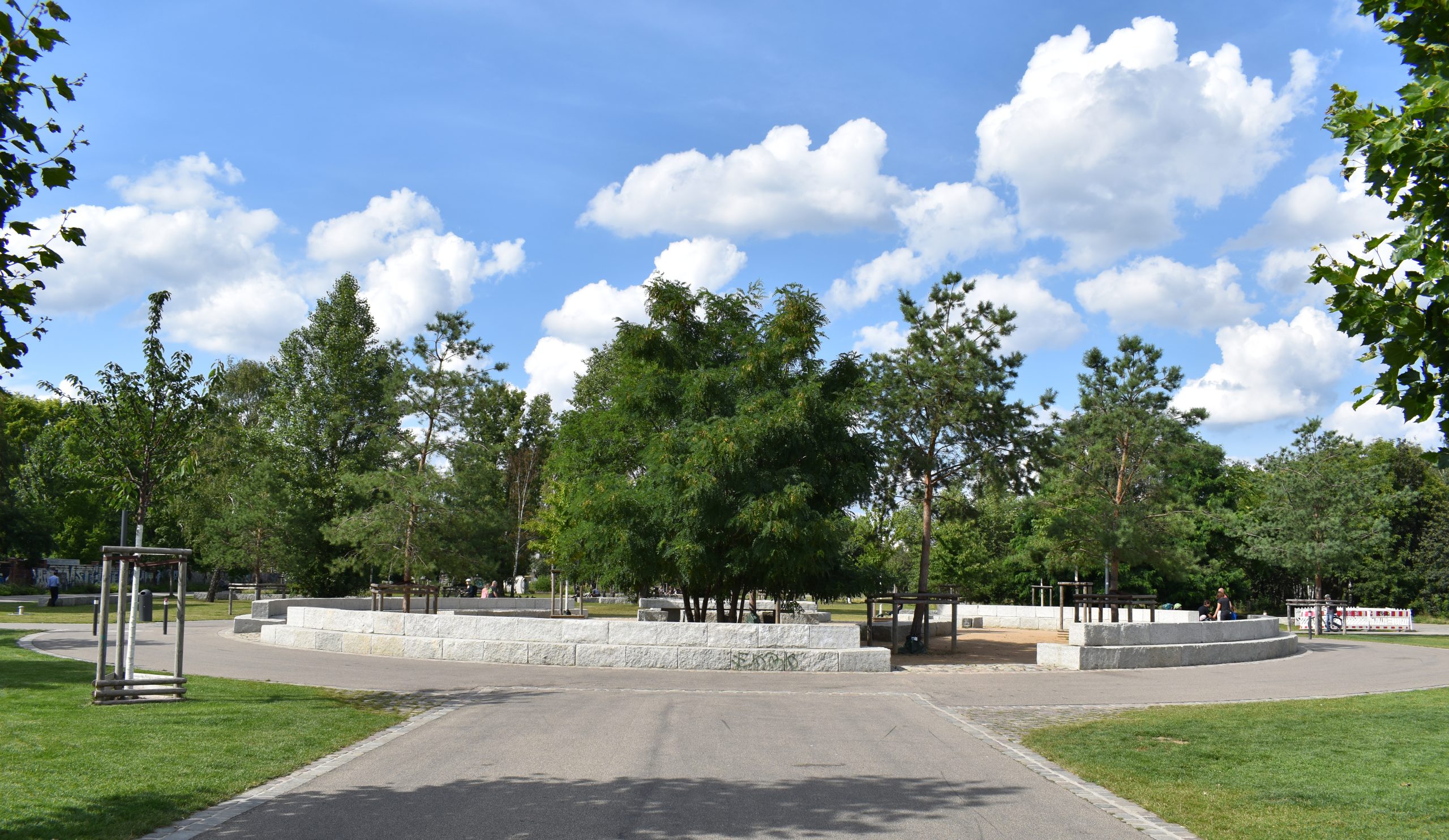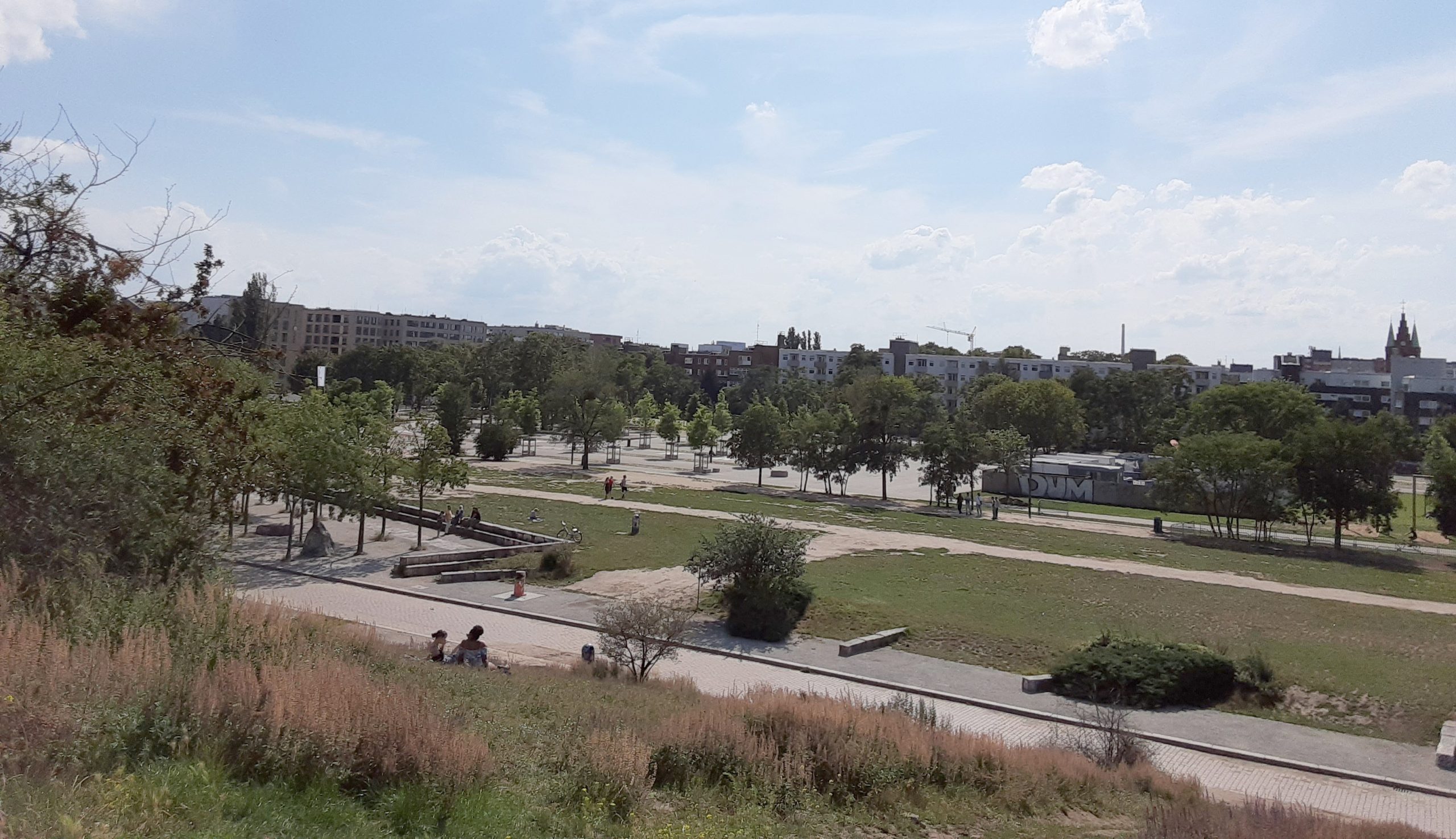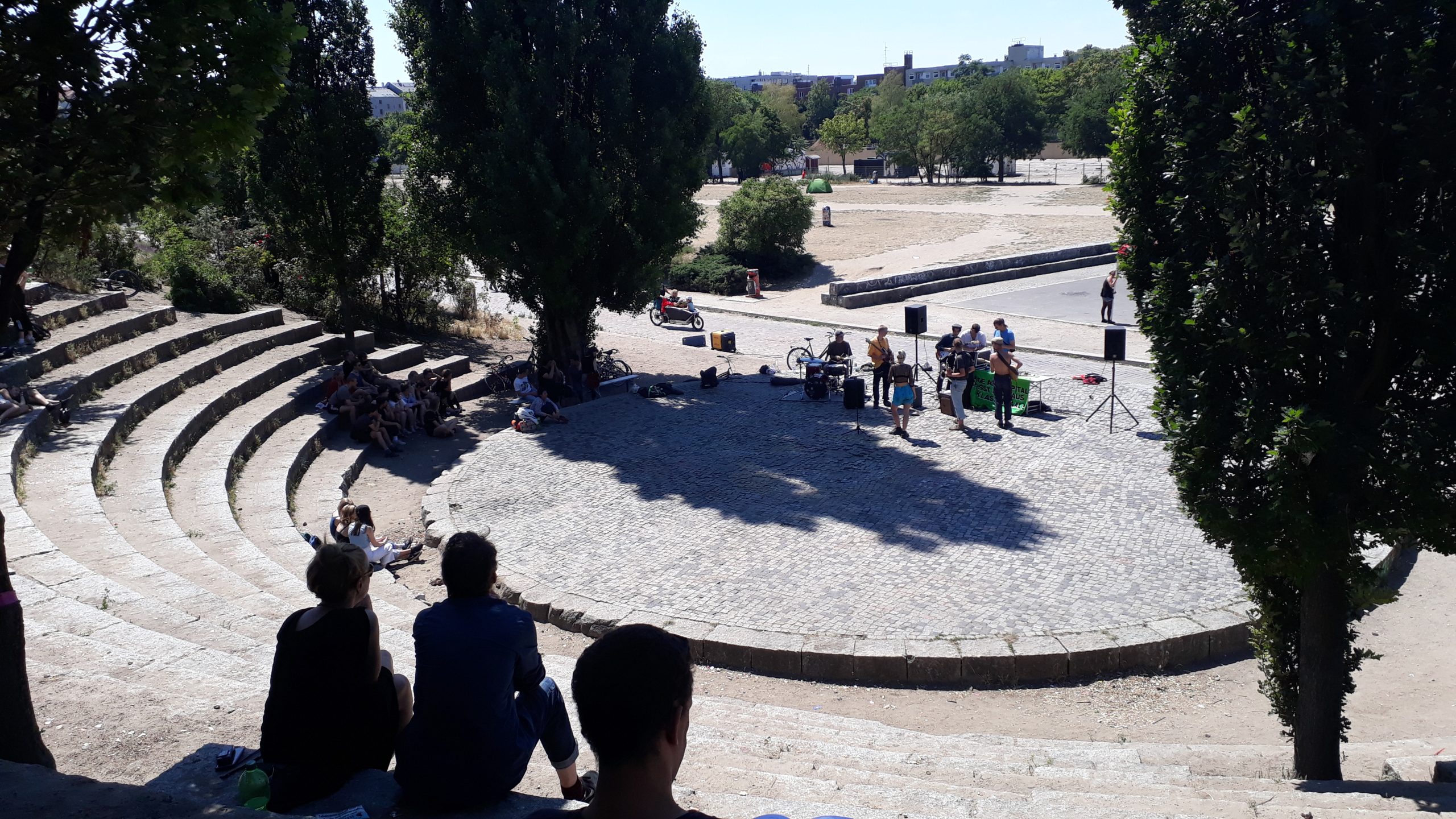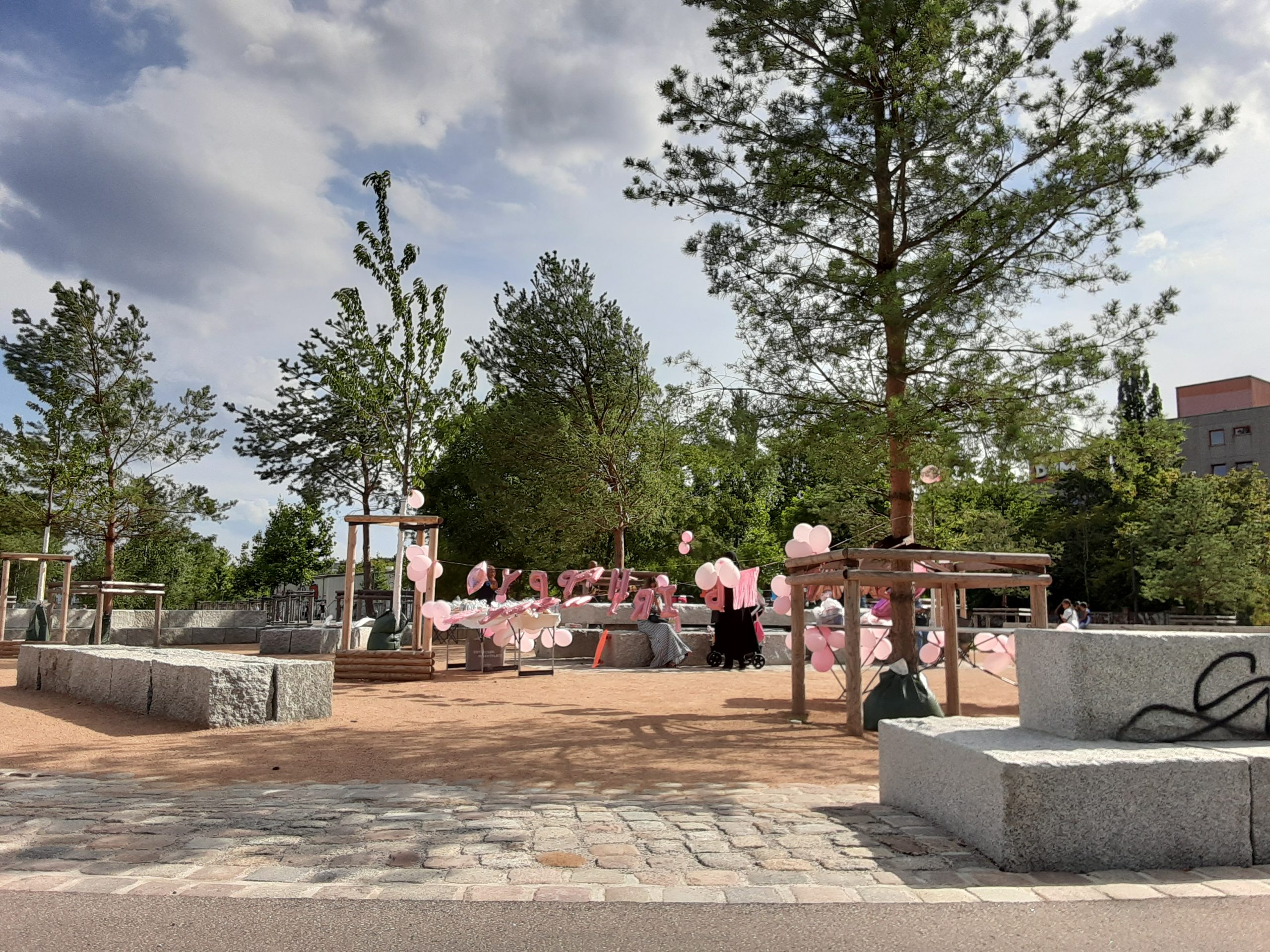
The Stone Circle in Berlins’ Mauerpark defines a meeting point for the two neighborhoods Wedding and Prenzlauer Berg.
Billboard
Skyscrapper
Halfpage
“The greatest design challenge is to create an empty space.” This quote by Gustav Lange forms the basis for understanding one of his most prominent projects, the Berlin Mauerpark. Like hardly any other, the Mauerpark reflects the design philosophy and attitude of its creator. It was the striving for emptiness, the space in between and chance that became apparent again and again in Lange’s planning. Lange was involved in the realisation of the last construction phase, which begun in 2020, until the very end. Gustav Lange died on 7 March 2022 in his adopted home of Schleswig-Holstein. In this article, we honour the Mauerpark as a complete work.
From border space to open space
For Lange, it was fundamental to preserve the openness of the former “death strip” within the polished border fortifications of the Berlin Wall in his design. Hence, at the interface between the two former political systems, he wanted to preserve a clearing in the city. On the way “from border space to open space”, he created a place to live and let live. The transformation of a negatively occupied open space into a positively occupied public park was the central challenge. In Lange’s design, the visitors eventually had the key role in this processual transformation. The planning merely provided the framework for the aesthetic superstructure and the material stage. Therefore, people can unfold to re-articulate and re-interpret the historical site.

Mauerpark from North to South
Firstly, the contaminated sandy area of the former “death strip” was removed. Then, its topsoil replacement became the fertile basis for and extensive “carpet of grass”. The uncovered historic pavement of “Schwedter Straße” later turned into the central park axis from north to south. At the entrance to Eberswalder Straße, a grove of trembling poplars welcomes you. It beckons friendly with its purring leaves in the light: “Come in!” At the other end, a grove of birch trees catches the wind and quotes distant Siberian expanses. In between – an empty field and lots of sky. In the distance you can even make out the Berlin TV tower on the Alex.
Openness and tolerance
The east side of the park – a ten-metre-high slope of World War II rubble. Here, wild sage blossoms under wild apples. At the top there is the Hinterland wall, which quickly became a constantly changing graffiti gallery. Five large swings await there and invite you to fly into Berlin’s evening sun. Further north, an amphitheatre is embedded in the hillside. Music plays in the shade of the columnar oaks and poplars – and not just for Sunday karaoke. No other place in the park makes a stronger commitment to openness and tolerance – a meeting place of cultures and generations.
Along Schwedter Straße, clearly set small squares line up in basic geometric shapes. As tilted rectangles, they overlap the street space. The circular stage of the amphitheatre even cuts through the kerb of Schwedter Street. Here, it is embraced by the larger arches of the seating steps. Meanwhile, granite blocks that are as rough as splits provide frame. However, there is still room for wildly vagabond plants in the large gaps between the blocks. Lange commented that “nature creates compositions that no man could ever create”.

Mauerpark – a competition
The origins of Mauerpark date back to the time immediately after the fall of the Berlin Wall. The same excavators used at Bernauer Street and Eberswalder Street after the exchange of territories in 1988 took out the wall elements that had been constructed in a straight line on 10 November 1989. Later, from June 1990, the Wall was dismantled. The raked strip of sand between Prenzlauer Berg and Wedding eventually became a meeting place between East and West. Visitors also took it over for spontaneous activities.
Under public pressure to secure the areas as public open spaces in the future, the Berlin Senate launched a “Sports City Berlin” competition in early 1992 as part of the 2000 Olympic bid. This included not only the Mauerpark but also the future Max Schmeling Hall next to the Friedrich Ludwig Jahn Sports Park. The landscape architect Gustav Lange, who worked in Hamburg, won the landscape planning section in cooperation with the architectural firm Schweger und Partner. In 1993, with the help of funding from the Allianz Environmental Foundation, construction work began on the 7-hectare eastern section. The first construction phase begun in autumn 1994.
Mauerpark – old and new
Overall, it took a long time for the planning measures on the western, 8-hectare part of Mauerpark to start. Without politicians and administrators exerting civic commitment and influence in the years since 2003, the park would not exist today. The decisive political decision in 2009 cleared the way for the transfer of the land from the owners’ hands. Otherwise, the construction of high-quality flats would have taken place at the expense of the neighbourhood-connecting park. From 2012 to 2016, Lange also took an active part in the citizens’ workshop “Completing Mauerpark”. He adapted his already historic design from 1993 in a dialogue with the participants. The users’ demands on a public space, the development of the established park and also the influence of the municipal institutions were challenging.
Line of unequal things
The site was partly an industrial wasteland, but was also characterised by interim uses worthy of preservation. These included the intercultural communal areas of the Mauergärtner in the northern part of the park, the beer gardens on Eberswalder Straße and the weekly flea market. There were also new areas for children’s play. It included a future cultural centre at the small industrial building “Kartoffelhalle”. All in all, the extension of the park was intended as a counterbalance to the busy eastern part and to offer additional spaces for quieter uses. This was also due to the directly adjacent residential development.
During underground construction work on the reservoir canal on Eberswalder Street, workers found artefacts of the Berlin Wall and an escape tunnel. In winter 2017/2018, a redesign entrance area on Eberswalder Street became part of the “Berlin Wall Memorial”. The as-built course of the section of the Wall from 1961-1989 was marked in the park at the intersection of the “old” and “new” park, the “line of unequal things” designated by Lange. The Berlin office BBS was commissioned for the implementation planning and construction supervision, while Gustav Lange continued to be responsible for the artistic supervision.

A park for everyone
Lange’s formal design language is continued in a somewhat more discreet manner in the Mauerpark extension. The neighbourhood meeting place at the stone circle has an exceptional position here. Under a grove of pines and wild cherries, children often spontaneously celebrate their birthdays. The circle, bordered by a double-sided granite bench, marks the intersection between Wedding and Prenzlauer Berg. The squares of meadow further north with the small play areas have become a popular meeting place for local yoga classes in the soft shade of the birch trees. The so called wall gardeners have also found a place here. The new part of the park has a more small-scale feel overall, which is not only a result of the diversified planning culture. It is a careful melange of traces of the former goods station with track remains, large stone paving patchwork and robust ruderal shrubs.
Freedom with things and spaces
The four-row plane tree promenade takes the 30- to 40-year-old crooked maple trees as a matter of course. The avenue creates a connection from the entrance on Bernauer Street to the “Kartoffelhalle” (potato hall). It also touches the multifunctionally used, asphalted area of the flea market. There, under the wide grid of sophors, people play basketball or take rollerblades for a spin. Children helped with the development of the playground, but other hands did the actual planning. Enclosed by a functional fence and equipped with shiny stainless steel equipment, they radiate a completely different character. “Freedom against a vision of order – abolish design” postulated journalist Niklas Maak. Furthermore, e criticised that freedom with things and spaces is increasingly becoming an exception in the design of cities.
Close to the spirit of time
Gustav Lange, on the other hand, pursued a design philosophy that enabled process-oriented openness within a formative and legible framework. This is also legible on the detailed level in Mauerpark. Rough joints, flexible gaps, raw granite blocks, in places the impression of the unfinished spreads. The poor maintenance of the park over the years sometimes reinforces this impression. But it is an expression of changing moments and motivation for self-determined, spontaneous action and changing actions close to the spirit of the time. In a certain sense, Lange and the Mauerpark embody a lively, pleasurable conflict between the formal and the accidental.

Restoration of the Mauerpark
Now that the last construction phase is complete, the city is concentrating on the restoration of the “old” Mauerpark. A broader public discussed the catalogue of measures. It is thereby not limited to replanting all the originally planned trees, repairing the swings that have been defective for a long time or making the slope accessible for the disabled according to current guidelines. It should also apply to the craftsmanship of the stonework, which Lange, as a trained stonemason, has always demanded and which was not always fulfilled in the extended section.
A piece of Berlin prairie
The balance between the executed original design of 1993 and the transformations caused by people and plants in the park call for a valuation and legibility of the individual layers of meaning and an attitude in the sense of the design author Gustav Lange. It is to be hoped that a sense of proportion will be applied here and that the free spirit and openness of the site will not be sacrificed to an inadequate perfectionism. Author David Wagner writes in his declaration of love for the park: “Oh, Mauerpark, I love your meadow, which now, in late summer, is no longer a meadow at all, an English lawn looks different. Mauerpark, you are a little steppe, a piece of Berlin prairie, looks as if herds of buffalo have trampled over you.”
Under the canopy of a formal and clearly readable design framework, breaks, gaps and interstices were needed for the spontaneous, the processual – be it vegetation or human appropriation.
I would like to thank Susanne Brehm, Jan Gustav Fiedler and Bernd Krüger for their suggestions and critical review.
Photos: Frank Sleegers
References:
Niklas Maak, „Freiheit gegen Ordnungsvision: Schafft das Design ab!“, Frankfurter Allgemeine Zeitung, 07.01.2020, https://headtopics.com/de/freiheit-gegen-ordnungsvision-schafft-das-design-ab-10543421
David Wagner, „Jede Woche Woodstock. Krähen, Kinder, Kiffer und natürlich Karaoke: Eine Liebeserklärung an den Mauerpark.“, Der Tagesspiegel, 01.09.2012, https://www.tagesspiegel.de/themen/umziehen-nach-berlin/mauerpark-jede-woche-woodstock/7083406.html
From September 4 – 9 2022 the 25th International Metropolis Conference is taking place in Berlin. Read everything you need to know about it here.












